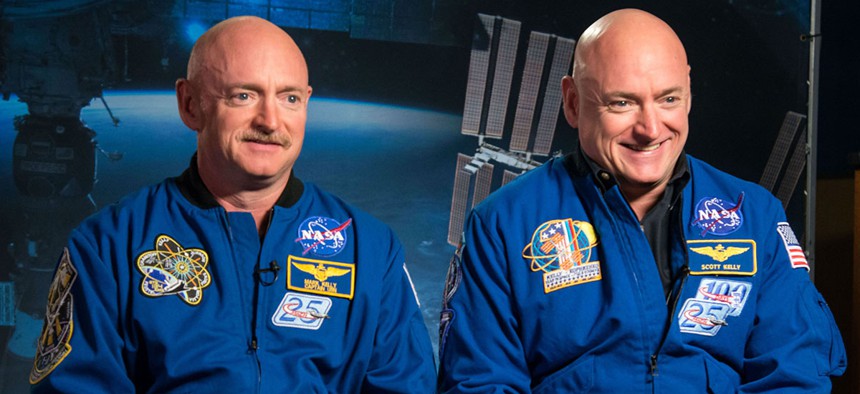If You Go Into Space For a Long Time, You Come Back a Genetically Different Person
Scott Kelly's year in space on the International Space Station made him a little less identical to his Earth-bound twin, Mark.
They say some trips change you. No one can relate more deeply than NASA astronaut Scott Kelly.
After spending 340 days on the International Space Station, Kelly returned to Earth. Six months later, scientists found that his genes had undergone seemingly permanent changes.
Kelly and his twin brother Mark provide a unique case study for what extended time in space does to the body. Because they are identical twins, the two essentially have the same set of genes (with a handful of single, benign mutations here and there). Both Scott and Mark are astronauts, but Mark only spent 54 days in space before retiring in 2011. Scott, on the other hand, spent almost a year orbiting the Earth on a mission that started in March 2015. Since his return, NASA scientists have been studying the differences between the two men.
The biggest change researchers noticed when Scott first returned to Earth was that he suddenly had two inches (five cm) on Mark, likely from being without gravity for such a long time. Over time, his height reverted. But less obvious changes to Scott’s genes may never reverse.
Genes are biology’s recipe book for making proteins, which ultimately dictate every single thing about us, from our eye and hair color to whether or not we can digest lactose. We inherit these genes from our biological parents, but how they work isn’t necessarily set in stone: things like environment and food intake can shape how these genes are available for interpretation.
About 7% of Kelly’s genes were chemically changed in a way that made them closed off, like pages from a book that become stuck together and unreadable. The code remained the same, but the body was suddenly unable to read the code for some of the proteins.
Christopher Mason, a geneticist and biochemist at Cornell University leading this part of the twin study, told Business Insider that some of these changes occurred in regions of Kelly’s DNA that code for vision and immune system function. However, none of these changes were big enough to generate major changes in body function; Scott himself said that he was surprised to hear that his DNA had been changed in an interview with MarketWatch.
NASA is referring to some of these changes as “space genes.” But that term is a little misleading, says Gavin Bascom, a chemist studying DNA structure at New York University unaffiliated with the work. “‘Space genes’ insinuates that the genes are…providing some adaptive advantage towards spaceflight when in fact the changes could be harmful over the long-term,” he says. It could be that these permanent changes for adapting in space aren’t so great for longevity.
Bascom also points out that it takes a lot less than space travel to alter how open or closed genes are for interpretation. “Gene activity is sensitive to all kinds of stuff—if you draw blood into a non-pressurized container, for example, the gene activity will be different than when it was inside you,” he says. The fact that Scott’s DNA was examined six months after his return could even mean that his gene expression was changed because he was readapting to life on Earth. To say for sure whether these changes were caused by his time in space, scientists would have to study Scott’s DNA for a longer period of time.
Mason and his team haven’t published their work in a peer-reviewed journal yet, meaning it hasn’t yet undergone rigorous scrutiny by external reviewers. NASA says the full results of this twin study will be published later this year—and are the precursor for a possible three-year mission to Mars.







